This spring I overhauled the front part of the front yard, getting rid of some scraggly dune sunflower and replacing it with some more long-lived plants. (Not that dune sunflower is bad or short-lived, but I have it in many other areas of the yard as well, and it needs frequent cutting back to keep it looking nice.)
I put in some of the usual suspects with lovely little flowers: beach creeper (Ernodia littoralis), blue porterweed (Stachytarpheta jamaicensis), and a few actual wildflowers (a wild petunia, among others). I also put in three (count ’em, three!) little plants on which I pinned some rather high hopes: Bahama senna (Senna mexicana var. chapmanii).
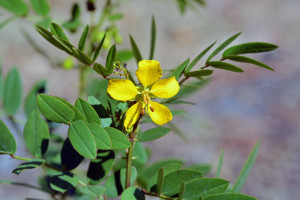
These are also called dwarf senna, so I suppose I shouldn’t count on them to grow very large, but the pictures I’ve seen of them in my plant guides show some tremendously flowering plants, with big yellow flowers dominating the scene. That one lonely bloom in the picture above was supposed to be just the first of many. Hasn’t worked out that way; once the blooms that were on the plants when I brought them home from the nursery were gone, there were no more. Rufino Osorio’s guide mentions that they flower most profusely in autumn and spring, so perhaps a long period of summer dormancy isn’t anything to worry about.
But they also never seemed to grow. Whenever I went out to look at them, I saw snapped-off new growth, as if the plants were just too brittle for our breezy locale. I checked for insect damage but could never find a culprit, even though I know that several lovely yellow butterflies use these as their larval host plants (which was one of the reasons I’d brought them into the garden, after all.)
Recently, however, as I was out pulling weeds after several months of heat-induced procrastination, I noticed what I’d probably just been overlooking for the past few months: a big, bright green and yellow caterpillar munching contentedly on the leaves, practically denuding the branches it was on:
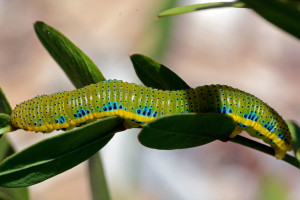
The bright blue outlines around the black spots, combined with the yellow racing stripe on a green body are distinguishing characteristics of the lovely Cloudless Sulphur butterfly, an insect whose devotion to its larval host plant is reflected in its taxonomic name: Phoebis sennae.
This caterpillar, despite its bright colors, just blends right into the leaves and stems of the host plant. It’s the same kind of camouflage enjoyed by some parakeets. Take a look at them out of their natural setting (on a telephone wire, for example) and you’d wonder just how in the heck they could ever conceal their bright green colors. Why haven’t they all been eaten by predators? But then you watch an entire flock of them just completely disappear into the green-leaved canopy of a large tree and it hits you: their camouflage is just perfect for where they evolved.
At least, that’s what I’m telling myself after months of apparent obliviousness to these quite large caterpillars trimming my bushes so effectively.
Here’s what this lovely young rascal will eventually turn into:
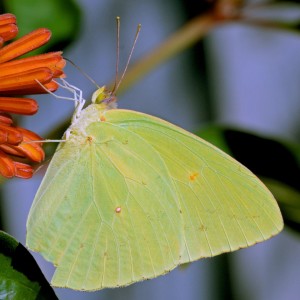
Here’s another shot of a different larva, from the top (I just love the symmetry of the spots and the “wings” of the senna leaves):
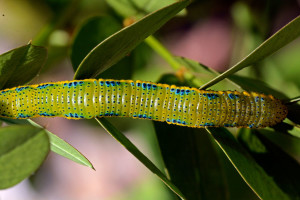
And a different adult:
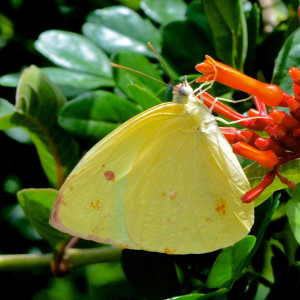
We have lots of butterflies here in south Florida. And if we plant pretty little plants that they enjoy, we can enjoy even more of them!
